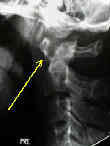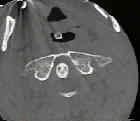- Discussion:
- rupture of transverse ligament is destabilizing injury that can occur in isolation or with atlantoaxial subluxation or an atlas fracture;
- transverse ligament is primary restraint to anterior translation of atlas in relation to the lower cervical spine;
- transverse lig can fail in midsubstance or avulsion of bone can occur;
- it has been estimated that a force of about 85 kg is required to rupture the transverse ligament;
- Clinical Presentation:
- pt can give history of flexion injury and has neck pain, occassionally w/ associated head injury;
- diffuse motor loss may occur if the pyramidal tract is affected;
- Radiographs:
- cross table lateral:
- plain radiographs reveal atlantodental interval (distance between anterior ring of atlas & odontoid process) of at least 4 mm;
- an anterior shift of C1 on C2 of more than 3-5 mm implies injury to transverse ligament;
- shift > 5 mm implies injury transverse & alar ligaments;
- accurate assessment can be made by performing a flexion extension CT scan;
- CT of C1 is often helpful in further delineating exact displacement of the fragments;
- traumatic atlas frx: (odontoid view);
- if lateral masses overhang articular surfaces of axis more than 7 mm, then transverse ligament is likely to be torn;
- this frx is therefore considered unstable and should be treated in a halo cast or skeletal traction for 3 months;
- if overhang is < 7 mm, then frx is stable and should be treated in rigid support, such as a cervicothoracic brace, for 3 mo;
- Treatment:
- can occur thru the midstubstance or thru bony avulsion;
- bony avulsion:
- should be documented by CT scan;
- halo immobilization may be used until healing of the avulsed ligament takes place;
- once healing is documented, repeat flexion and extension are made to assess transverse ligament competency;
- midsubstance tears:
- w/ greater than 5 mm of C1-C2 subluxation, atlantoaxial fusion should be performed



